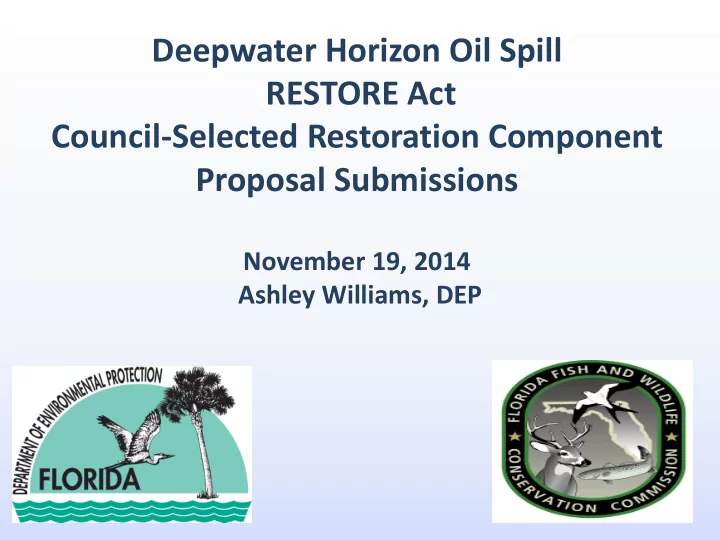

Deepwater Horizon Oil Spill RESTORE Act Council-Selected Restoration Component Proposal Submissions November 19, 2014 Ashley Williams, DEP
The RESTORE Act The RESTORE Act was signed into law on July 6, 2012 by the President. It accomplishes: • the creation of the Gulf Coast Restoration Trust Fund • an outline for the proper use of the Trust Fund • the establishment of the Gulf Coast Ecosystem Restoration Council August 28, 2013 - The Council released the Initial Comprehensive Plan August 15, 2014 - US Dept. of Treasury released Trust Fund regulations August 21, 2014 - Council-Selected Restoration Component (Bucket 2) submission window opened for Council members November 17, 2014 – Deadline for Bucket 2 proposal submissions
ALLOCATION OF RESTORE ACT FUNDS Council-Selected Restoration Component 20% Oil Spill Clean Water Act Penalties Liability Trust Fund 80% Gulf Coast Restoration Trust Fund 30%* Gulf 2.5%* Gulf Coast 35% Equally Coast 30% Impact Ecosystem distributed to 2.5%* Ecosystem based Restoration Science, 5 Gulf States Centers of Restoration distribution to Observation, (AL, FL, LA, Excellence Council for 5 Gulf States Monitoring, and MS, TX) ecosystem (AL, FL, LA, Technology Program restoration MS, TX) Direct Council-Selected Spill Impact Sec 1604/RESTORE Centers of Component Restoration Component Science Program Excellence Component *Supplemented by interest generated by the Trust Fund (50% to Gulf Coast Ecosystem Restoration Council, 25% to Science Program, 25% to Centers of Excellence)
Process for Council-Selected Restoration Component (Bucket 2) Projects Submitted. Projects may focus on Habitat and Water Quality goals, with an emphasis on projects that are foundational, sustainable, have a high probability of success and that have community benefits. Project Vetting Activities Eligibility Verification and Budget Reasonableness, Coordination Reviews Priority and Environmental Science Commitment to Compliance Evaluation Plan Evaluation Readiness Results from proposal submission and evaluation will be compiled into a context report and attached to each proposal to aid in the development of a draft Funded Priorities List.
Successful Project Proposals for the Council- Selected Restoration Component • Water quality and habitat focus • Reasonable cost • Gulf-wide significance • Wide-spread support • Scientifically-sound • Meets the goals and objectives outlined in the Initial Comprehensive Plan • Environmental compliance status
Florida’s Restoration Priorities • Stormwater / Wastewater • Community resilience / Living shorelines • Water quality projects • Agriculture BMPs • Fish and wildlife habitat and management
How Florida reached the five proposals • DEP’s project portal • Extensive outreach efforts • Public input • Intersection of common interests
Submitted Projects to Date
Outreach Activities • Two Webinars - 125+ participants on each • Florida Association of Counties and Gulf Consortium • NGOs • Gulf Coast Counties • State agencies • Federal Agencies • Other States • NEPs
Managing Expectations for Bucket 2 • $150 to $180 million available Gulf- Wide • 5 proposal limit per Council member • Competitive - no guarantee that any proposal will be selected
Florida’s Five Proposals
Florida’s Five Proposals • Pensacola Bay Watershed Restoration - $15.9 million • Apalachicola Bay Watershed Restoration - $26.1 million • Suwannee River Watershed Restoration and Preservation - $12.1 million • Tampa Bay Watershed Restoration - $6.9 million • Northwest Florida Estuaries Restoration - $16.8 million Total - $77.9 million
Pensacola Bay Watershed Restoration Projects
Pensacola Bay Watershed Restoration Projects • Pensacola East Bay Living Shoreline • Pensacola Bay Living Shoreline • Pensacola Beach Reclaimed Water System • Beach Haven – Joint Stormwater & Wastewater • Bayou Chico Contaminated Sediments Total - $15.9 million
Apalachicola Bay Watershed Restoration Projects
Apalachicola Bay Watershed Restoration Projects • Restoration –Tate’s Hell State Forest • Restoration - Wildlife Management Areas • Money Bayou Restoration • Marsh and Oyster Reef Restoration at Apalachicola NERR • Agriculture Water Quality Improvement • Bay Oyster Restoration Total $26.1 million
Suwannee River Watershed Restoration Projects
Suwannee River Watershed Restoration Projects • Oyster Reef Resilience • Lower Suwannee & Gulf Watershed Conservation Easements • Suwannee River Partnership Irrigation Water Enhancement Program Total $12.1 million
Tampa Bay Watershed Restoration Projects
Tampa Bay Watershed Restoration Projects • Robinson Preserve Restoration • River Tower Shoreline Restoration and Stormwater Treatment • Palm River Stormwater and Habitat Restoration • Edward W. Chance Reserve Hydrologic Restoration • Alafia Bank Bird Sanctuary Living Shoreline Total $6.9 million
Northwest Florida Estuaries & Watersheds Restoration Projects
Northwest Florida Estuaries & Watershed Restoration Projects • Update Watershed Management Plans • Design and Permitting • Implementation of Projects • Project Monitoring Total amount requested: $16.8 million
Next steps • All proposals posted on Council website • The amount of funding available for the first FPL is approximately $150-$180 million • Competitive - no guarantee that any proposal will be selected • Council members will work to create the draft FPL once all proposals are reviewed for eligibility • Public review of draft FPL • Final FPL
National Fish and Wildlife Foundation 2014 Funding Cycle: 9 Florida projects totaling $34.3 million • Restoration and Management of Escribano Point Coastal Habitat – Phase II -$1,486,800 • Enhanced Assessment for Gulf of Mexico Fisheries – Phase II -$3,000,000 • Florida Shorebird Conservation Initiative -$1,489,800
National Fish and Wildlife Foundation • Benthic Habitat Mapping, Characterization and Assessment -$4,477,900 • Oyster Reef Habitat Restoration in Saint Andrew Bay - $1,973,500 • Restoration of Florida’s Coastal Dune Lakes -$3,045,400 • Bayou Chico Restoration -$11,032,300 • Destin Harbor, Joe’s Bayou, and Indian Bayou Water Quality Improvement -$3,593,600 • Boggy Bayou Watershed Water Quality Improvement - $4,223,000
Questions For more information visit: www.deepwaterhorizonflorida.com Contact: Phil Coram, P.E. (850) 245-2167 Phil.coram@dep.state.fl.us Ashley M. Williams, Gulf Coast Public Affairs Manager (850) 245-2197 Ashley.M.Williams@dep.state.fl.us
Recommend
More recommend